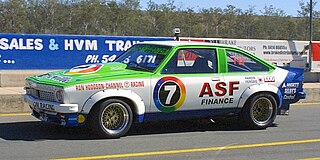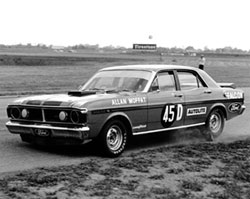The 1981 Australian Touring Car Championship was a CAMS sanctioned motor racing title for drivers of Group C Touring Cars. The championship, which was the 22nd running of the Australian Touring Car Championship, began at Symmons Plains Raceway and ended at Lakeside International Raceway after 8 rounds.

In relation to Australian motorsport, Group C refers to either of two sets of regulations devised by the Confederation of Australian Motor Sport (CAMS) for use in Australian Touring Car Racing from 1965 to 1984. These are not to be confused with the FIA’s Group C sports car regulations, used from 1982 to 1992 for the World Endurance Championship / World Sports-Prototype Championship / World Sportscar Championship and the 24 Hours of Le Mans.
The 1995 Australian Super Touring Championship was a CAMS sanctioned motor racing championship for 2 Litre Super Touring Cars. It was the third series for 2 litre Super Touring Cars to be contested in Australia, but the first to use the Australian Super Touring Championship name. It began on 5 March 1995 at Phillip Island Grand Prix Circuit and ended on 26 August at Eastern Creek Raceway after eight rounds.
The National Series for Sports Sedans , formerly the Australian Sports Sedan Championship, is a CAMS sanctioned national motor racing title for drivers of cars complying with Australian Sports Sedan regulations. This class, essentially a silhouette racing car class, caters for cars of essentially free construction but utilising some of the bodywork of a closed, series production vehicle.
The Australian Endurance Championship is an Australian motor racing title which has been awarded by the Confederation of Australian Motor Sport in numerous years and for numerous categories since 1981.
The 1991 Australian Endurance Championship was a CAMS sanctioned Australian motor racing title open to Group 3A Touring Cars. The championship, which was the eighth running of the Australian Endurance Championship, began on 8 September 1991 at Sandown Raceway and ended on 6 October at the Mount Panorama Circuit after two rounds. The title was won by Mark Gibbs and Rohan Onslow who shared a Bob Forbes Racing Nissan Skyline GT-R. The 1991 Australian Manufacturers' Championship, which was run concurrently with the Endurance Championship, was awarded to the Nissan Motor Co (Australia).
The Australian Super Touring Championship was a CAMS-sanctioned national motor racing title for Super Touring Cars.
The 1993 Australian Touring Car Championship was a CAMS sanctioned Australian motor racing title for Group 3A Touring Cars. The championship, which was the 34th Australian Touring Car Championship, was contested over a nine-round series which began on 28 February 1993 at Amaroo Park and ended on 8 August at Oran Park Raceway. Promoted as the Shell Australian Touring Car Championship, it was won by Glenn Seton, driving a Ford EB Falcon, with teammate Alan Jones completing a one-two championship result for Glenn Seton Racing. It was Seton's first championship victory and the first major victory for the team he had started in 1989.
The 1998 Australian Touring Car Championship was an Australian motor racing competition open to 5.0 Litre Touring Cars,. The championship, which was sanctioned by the Confederation of Australian Motor Sport as an Australian title, was contested over a ten-round series which began on 1 February 1998 at Sandown International Motor Raceway and ended on 2 August at Oran Park International Raceway. The series was promoted as the "Shell Australian Touring Car Championship". The title, which was the 39th Australian Touring Car Championship, was won by Craig Lowndes.
The 1997 Australian Touring Car Championship was a CAMS sanctioned Australian motor racing title open to 5.0 Litre Touring Cars complying with Group 3A regulations. The championship, which was the 38th Australian Touring Car Championship, began on 15 March at Calder Park Raceway and ended on 3 August at Oran Park Raceway after 10 rounds.
The 1986 Australian Endurance Championship was a CAMS sanctioned motor racing title open to Touring Cars as specified in the National Competition Rules of CAMS. The title, which was the sixth Australian Endurance Championship, was contested concurrently with the 1986 Australian Manufacturers' Championship, which was the sixteenth in a sequence of manufacturers championships awarded by CAMS, and the seventh to be contested under the Australian Manufacturers' Championship name.

The 1996 Australian Touring Car Championship was a CAMS sanctioned motor racing title for drivers of 5.0 Litre Touring Cars complying with Australian Group 3A regulations. The championship, which was the 37th Australian Touring Car Championship, was promoted as the Shell Australian Touring Car Championship. It was contested over ten rounds between January 1996 and June 1996. The season was contested earlier in the year than usual as much of telecaster Channel 7's broadcast equipment was required for its 1996 Summer Olympics coverage, and was in fact the last year Channel 7 would broadcast the series until 2007, with Network Ten taking over the broadcast rights from the 1997 season onwards. The series was won by Craig Lowndes driving a Holden Racing Team Holden VR Commodore.
The 1999 Australian Super Touring Championship was an Australian motor racing competition for Super Touring Cars. It began on 18 April 1999 at Lakeside International Raceway and ended on 29 August at Calder Park Raceway after eight rounds and twenty one races. Promoted as the BOC Gases Australian Touring Car Championship, organised by TOCA Australia and sanctioned by the Confederation of Australian Motor Sport as an Australian Title, it was the seventh annual Australian championship for Super Touring Cars and the fifth to carry the Australian Super Touring Championship name.
The 1979 Australian Touring Car Championship was a CAMS sanctioned Australian motor racing title open to Group C Touring Cars. It began at Symmons Plains and ended at Adelaide International Raceway after eight rounds. The title, which was the 20th Australian Touring Car Championship, was won by Bob Morris driving a Holden Torana.
The 1978 Australian Touring Car Championship was a CAMS sanctioned Australian motor racing title open to Group C Touring Cars. The title, which was the 19th Australian Touring Car Championship, was won by Peter Brock. It was his second Australian Touring Car Championship victory.

Group E Series Production Touring Cars was an Australian motor racing category for production based sedans competing with limited modifications. It was current from 1964 to 1972.
The 1987 Australian Manufacturers' Championship was a CAMS sanctioned motor racing title for car manufacturers. The title, which was the seventeenth Australian Manufacturers' Championship, was contested concurrently with the 1987 Australian Touring Car Championship over a nine-round series.
The 1988 Australian Drivers' Championship was a CAMS sanctioned national motor racing title which was awarded to the winner of the 1988 Australian Formula 2 Championship. Australian Motor Racing Year page 181 indicates that the 1988 AF2C winner was awarded the CAMS Gold Star but that it was not certain that the series could be called the 1988 Australian Drivers' Championship. The 2002 CAMS Manual of Motor Sport, page 14-4, however lists Onslow as the winner of the 1988 Australian Drivers' Championship. The winning driver received the 1988 CAMS Gold Star and is recognised by CAMS as the winner of both the 43rd Australian Drivers' Championship and the 21st Australian Formula 2 Championship. 1988 was the second and last year in which the Australian Drivers' Championship was contested by Australian Formula 2 cars, this being an interim arrangement between the demise of Formula Mondial in Australia at the end of 1986 and the introduction of Formula Holden in 1989.
Group D Production Sports Cars was a CAMS motor racing category current in Australia from 1972 to 1981.




